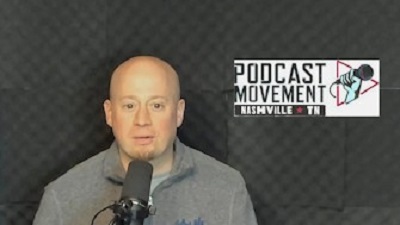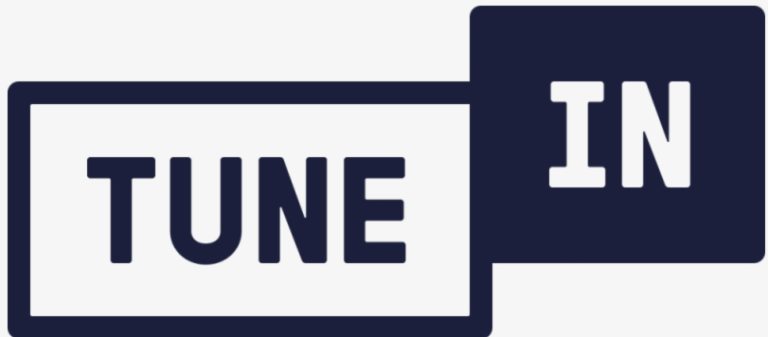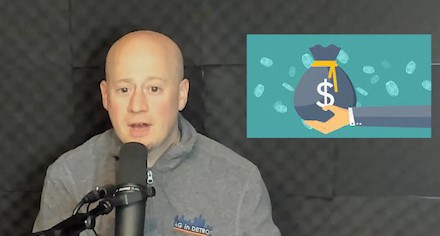
Listen Here on The Web
Or Watch Here on YouTube:
Transcript/Show Notes:
As always, I learned a lot at this year's Podcast Movement convention, and I'm going to share it with you today.
(NEW OPEN)
Welcome in, I'm Jon Gay. You'll notice I shortened the intro. I talked to some listeners at Podcast Movement, and the consensus was that while a bunch of artists saying my name sounds cool, it has nothing to do with podcast news. It was great for my ego, but that's about it. Also, after a week of networking and socializing, my voice isn't 100%, but here goes.
Podcast Movement started out with Kate Erickson of the successful podcast Entrepreneur On Fire. She talked about podcast workflow in four steps. 1) Idea, 2) Commitment 3) Support 4) Plan. She also discussed tools such as an application form for guests, an online scheduler, Google Alerts, and more. My big takeaway was the Google Alerts. If you find yourself coming up short on topic ideas, use Google Alerts for the topic of your show. Link to Kate's workflow: https://www.eofire.com/podcastworkflow
The keynote we were all waiting for was Tom Webster of Edison Research. People always ask “How can I grow my audience?” What they should be asking is “Why did it stop growing?” Well, it's because people stopped recommending it! Recommendability: know who you are here for, and WHY they are there. Make the show easy to recommend, and master your craft, aka be recommendable!
Webster is also Bullish on the soon-to-be-released Facebook audio tools. Facebook is still the biggest social media player out there, and among non-podcast listeners, it's huge. So if Facebook users get their hands on podcasts, that can be a growth opportunity for all of us.
Tom says that in 2021, YouTube has become a major player in podcast discoverability. In fact, it's now third in terms of apps behind Spotify at #1, and Apple at #2. Think about it. Google Search is still dominant - and Google owns YouTube. So if your podcast is on YouTube, and the description is search engine optimized, you'll pop up in results. Now this isn't to say you have to have a video version of your show. But at least put the audio with a logo on YouTube with a good description. It will help your searchability.
Email is an important tool in marketing your podcast. Great session from Meghan Neasta of AWeber. Social media is great, but you're dependent on someone else's algorithm. Email lets you reach your audience directly, and see data on open rates and clickthroughs. It's also a great way to build personal connections and offer bonus content.
Another great Wednesday session was Todd Cochrane of Blubrry. Having a website for your podcast is absolutely crucial. Now I caught Todd in the Starbucks line and he told me you don’t have to have a separate website for your show if it’s a branded podcast and you’re trying to get people to YOUR website. But if the show stands alone, it needs its own site – not just the one your host gives you.
However, whichever way you do it, with Google Search so big, search engine optimization is KEY. Todd’s action items include having great episode titles and supporting show notes, making it easy to subscribe, contact, and listen, asking for reputable backlinks to your content from folks (Google loves this), and making sure your website is not just mobile friendly, but mobile first.
As Wednesday wrapped up, I saw my buddy Jay Nachlis from Coleman Insights, talking about using Blue Ocean strategy to find your podcast niche. If you don’t know the analogy, red ocean is where the sharks are, looking for chum. Blue ocean is wide open with endless possibilities. For example, your science podcast may have a lot of competition. But if you focused just on chemistry, you’d be more unique. There are podcasts about the Golden State Warriors, but none specifically about Steph Curry. If you niche down your podcast, you’ve got a greater chance of success.
Thursday’s opening keynoter was Shark Tank entrepreneur Mark Cuban. He and co-founder Falon Fatemi were talking about their fireside platform. The idea behind fireside is that you’ll get better real time analytics than podcast hosts, but the whole session turned into an infomercial, where they became pigeons and they made podcasting their park bench. This in front of an audience of podcasters. Read the room, dude. Not only did you shamelessly plug your new venture, you insulted your audience in the process.
On the flip side, Thursday’s highlight was Rob Walch from Libsyn, and his annual “Yes, that marketing advice for your podcast is BS.” His 2021 version was VERY informative.
I’ve spent a lot of time dunking on Apple Podcasts in recent weeks, but according to Libsyn’s stats, they are still far and away #1 for podcasts. Part of the reason is that there’s 120 DIFFERENT podcast apps that pull FROM Apple! So while Spotify is spending money, grabbing headlines, and is, in my opinion a better user experience, Apple is still king. Your podcast HAS to be on Apple.
When you start a podcast, it might be intimidating to hear that there are now 2.3 million podcasts out there. Well guess what? The number of ACTIVE shows are declining. Of those 2.3 million shows, only 322 thousand have done at least 10 episodes and are still creating content– that’s only 14%!
Next myth from Rob Walch: your podcast needs to be on video. Not true – many of the top podcasts are audio only. We have more time in the day to consume audio than video, because audio is portable. Now, again, it’s good to have a presence on YouTube, but that can be as simple as uploading your audio with a logo.
Rob also had some best practices to share from Apple Podcasts. #1, the first 30 seconds of your last episode are your most important – that’s what people will hear first. Also, don’t worry about picking a third category in Apple. Fill out the copyright field and content rating (explicit or not).Also, while you can swear in your show, DON’T swear in your title or description – Apple’s bots can kick you out for that.
Submit a trailer to Apple 30 days prior to launching your show. It’s rare that it takes that long, but if you’re planning a campaign around launching your show, you want to be sure that the show exists before you promote it. Also, I can’t say this enough – ratings and reviews DO NOT MATTER. This isn’t Yelp or Trip Advisor. Yes, they’re great for your ego and positive reinforcement, but it has nothing to do with Apple charts. The best way to grow your show is to get people to FOLLOW it (don’t say subscribe) and recommend it to your friends. To be successful, you need both good content AND interaction.
Finally, Rob was really passionate about privacy. Yes, your IP address is personally identifiable information. That’s why we are seeing restrictions on collecting IP addresses in Europe, California, and Colorado, with more regulations to come. This will likely have an effect on Dynamic Ad Insertion going forward. Think about it – if a potential employer or foreign government could learn which podcasts you searched for or listened to – that’s potentially VERY dangerous.
You know who commands more revenue than all of podcasting, without knowing their users’ IP addresses? The Super Bowl. Rob didn’t say this specifically, but if you take the time to get to know your listeners, you’ll be able to serve them relevant ads just fine.
Link to all of Rob's outstanding info, shared with his permission: https://traffic.libsyn.com/secure/lilith/411_PM21_Marketing_BS.pdf
My two big action items coming out of Podcast Movement: optimize my podcast and website for SEO, and start an email list, where I can send you my content every week. If you'd like to sign up, you can do so here: http://jagindetroit.com/subscribe
Finally, it was really great to attend an in person event. Yes, there was some angst about the Delta variant, but as a vaccinated person, I took some calculated risks. I don't have any symptoms, but I got COVID tested before I left and when I got back, because I felt it was the responsible thing to do after being around so many people. Seth Resler of Jacobs Media did a great write-up on the "weirdness" of attending an event in person at this stage in the pandemic. You can read it here. https://jacobsmedia.com/what-its-like-to-return-to-an-in-person-conference/
There were so many panels that I wanted to attend, but couldn't be multiple places at once. Once the videos are posted online, I'll have more to consume, and hopefully more to report back to you. Until next time, stay healthy and stay safe. Lata!










